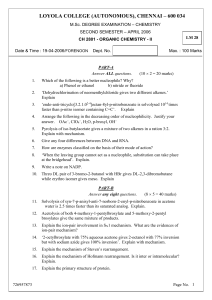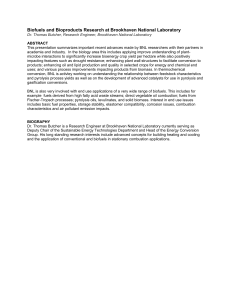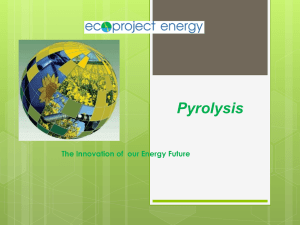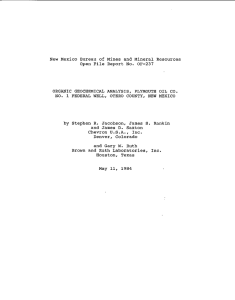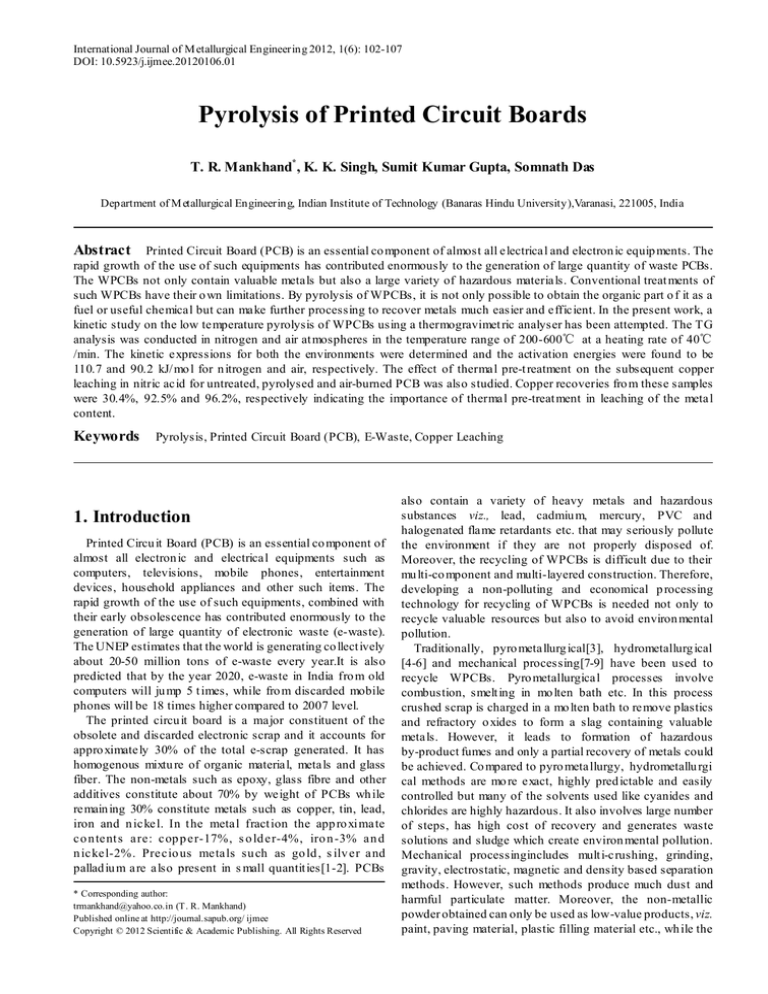
International Journal of M etallurgical Engineering 2012, 1(6): 102-107
DOI: 10.5923/j.ijmee.20120106.01
Pyrolysis of Printed Circuit Boards
T. R. Mankhand* , K. K. Singh, Sumit Kumar Gupta, Somnath Das
Department of M etallurgical Engineering, Indian Institute of Technology (Banaras Hindu University),Varanasi, 221005, India
Abstract Printed Circuit Board (PCB) is an essential co mponent of almost all electrical and electron ic equip ments. The
rapid growth of the use of such equipments has contributed enormously to the generation of large quantity of waste PCBs.
The WPCBs not only contain valuable metals but also a large variety of hazardous materials. Conventional treat ments of
such WPCBs have their o wn limitations. By pyrolysis of WPCBs, it is not only possible to obtain the organic part o f it as a
fuel or useful chemical but can make further processing to recover metals much easier and efficient. In the present work, a
kinetic study on the low temperature pyrolysis of WPCBs using a thermogravimet ric analyser has been attempted. The TG
analysis was conducted in nitrogen and air at mospheres in the temperature range of 200-600℃ at a heating rate of 40℃
/min. The kinetic expressions for both the environments were determined and the activation energies were found to be
110.7 and 90.2 kJ/ mo l for n itrogen and air, respectively. The effect of thermal pre-t reatment on the subsequent copper
leaching in nitric acid for untreated, pyrolysed and air-burned PCB was also studied. Copper recoveries fro m these samples
were 30.4%, 92.5% and 96.2%, respectively indicating the importance of thermal pre-treat ment in leaching of the metal
content.
Keywords
Pyrolysis, Printed Circuit Board (PCB), E-Waste, Copper Leaching
1. Introduction
Printed Circu it Board (PCB) is an essential co mponent of
almost all electron ic and electrical equipments such as
computers, televisions, mobile phones, entertainment
devices, household appliances and other such items. The
rapid growth of the use of such equipments, combined with
their early obsolescence has contributed enormously to the
generation of large quantity of electronic waste (e-waste).
The UNEP estimates that the world is generating co llect ively
about 20-50 million tons of e-waste every year.It is also
predicted that by the year 2020, e-waste in India fro m old
computers will ju mp 5 t imes, while fro m discarded mobile
phones will be 18 times higher compared to 2007 level.
The printed circu it board is a major constituent of the
obsolete and discarded electronic scrap and it accounts for
appro ximately 30% of the total e-scrap generated. It has
homogenous mixtu re of organic material, metals and glass
fiber. The non-metals such as epoxy, glass fibre and other
additives constitute about 70% by weight of PCBs wh ile
remain ing 30% constitute metals such as copper, tin, lead,
iron and n ickel. In t he metal fract ion the app ro xi mate
co n tent s are: cop p er-17%, s o ld er-4%, iro n -3% an d
n ickel-2%. Precio us metals su ch as go ld , s ilv er and
pallad iu m are also present in s mall quantit ies[1-2]. PCBs
* Corresponding author:
trmankhand@yahoo.co.in (T. R. Mankhand)
Published online at http://journal.sapub.org/ ijmee
Copyright © 2012 Scientific & Academic Publishing. All Rights Reserved
also contain a variety of heavy metals and hazardous
substances viz., lead, cadmiu m, mercury, PVC and
halogenated flame retardants etc. that may seriously pollute
the environment if they are not properly disposed of.
Moreover, the recycling of WPCBs is difficult due to their
mu lti-co mponent and multi-layered construction. Therefore,
developing a non-polluting and economical p rocessing
technology for recycling of WPCBs is needed not only to
recycle valuable resources but also to avoid environ mental
pollution.
Traditionally, pyro metallurg ical[3], hydrometallurg ical
[4-6] and mechanical processing[7-9] have been used to
recycle WPCBs. Pyro metallurgical processes involve
combustion, smelt ing in mo lten bath etc. In this process
crushed scrap is charged in a mo lten bath to remove plastics
and refractory o xides to form a slag containing valuable
metals. However, it leads to formation of hazardous
by-product fumes and only a partial recovery of metals could
be achieved. Co mpared to pyro metallurgy, hydrometallu rgi
cal methods are mo re exact, highly pred ictable and easily
controlled but many of the solvents used like cyanides and
chlorides are highly hazardous. It also involves large number
of steps, has high cost of recovery and generates waste
solutions and sludge which create environ mental pollution.
Mechanical processingincludes mult i-crushing, grinding,
gravity, electrostatic, magnetic and density based separation
methods. However, such methods produce much dust and
harmful particulate matter. Moreover, the non-metallic
powder obtained can only be used as low-value products, viz.
paint, paving material, plastic filling material etc., wh ile the
103
International Journal of M etallurgical Engineering 2012, 1(6): 102-107
precious metals may be lost as they usuallyadhere to the
non-metallic powder in crushing and grinding.
Pyrolysis is a thermochemical decomposition of organic
material at elevated temperatures (generally without the
participation of o xygen). It involves the simultaneous change
of chemical co mposition and physical phase, and is
irreversible. It can be considered as an alternative method for
recycling PCB, because in the pyrolysis process, the organic
part is decomposed to low molecu lar products (liquids or
gases), which can be used as fuel or chemical source,
furthermore PCB changes brittle, undergoes delamination
which could be easily crushed, while the inorganic part such
as glass-fibre remain fairly intense, which can be recycled
into other composites or any other materials[10-11].
Pyrolysis is a thermal recycling technique that has been
widely researched as a method of recycling synthetic
polymers including poly mers that are mixed with glass fibres.
Although a significant amount of research into the pyrolysis
of PCBs has been reported, most of the work has been carried
out under nitrogen atmosphere using analytical pyrolysis
techniques or laboratory scale reactors involving
measurement of kinetics[12-15] and characterization of its
products obtained[16-18].
In this present study a kinetic analysis of the low
temperature pyrolysis of WPCBs has been studied under
nitrogen and air atmosphere. The effect of thermal
pre-treat ment on the leaching of copper from untreated,
pyrolysed and air-burned (co mbustion) samples was also
examined.
2. Experimental
2.1. Materials
Printed Circu it Boards (PCBs), (a part of co mputer
mother board) were collected fro m old and obsolete
computers through local sources (Figure.1 (a)). The
batteries, capacitors and other electronic devises fro m PCBs
were mechanically removed in order to get clean and
component free PCBs. A nu mber o f such boards were
crushed using laboratory jaw crusher to get pieces in the
size range of 3-5 cm. These large p ieces were further
reduced to size of 3-5 mm (Figure.1 (b)) using a manual
cutter.
Figure 1. (a)PCB from computer mother board (b) after cutting
2.2. Apparatus and Methods
2.2.1. Pyrolysis
The PCB particles of the size in the range of 3-5mm were
subjected to pyrolysis under nitrogen atmosphere using a
thermogravimet ricanalyser. It measures continually the
change in weight of the samples undergoing reactions at the
specified temperatures with the help of a cathetometer. A
schematic diagram of the apparatus is shown Figure. 2.
Figure 2. Schematic diagram of the thermogravimetric apparatus.(1)
Nitrogen Cylinder (2) Furnace (3) Temperature Controller (4) Condenser
(5) Distilled Water (6) H2 SO4 Solution (7) NaOH Solution (8)Valve (9)
Cathetometer (10) Pyrex T ube (11) Silica T ube (12) Calibrated Spring
It consisted of a spring assembly, fixed to a vertically
mounted transparent silica tube, which itself was placed in a
vertically movable resistance furnace. Fro m the prior
calibrated spring fixed in the upper part of the assembly, a
silica crucible containing the samp le was suspended in the
silica tube. The furnace was aligned to bring the sample
crucible in the middle of the fu rnace. The temperature of the
furnace was measured by inserting a thermocouple fro m the
bottom of the silica tube. During pyrolysis of the PCB
samples, the weight loss was continually monitored with the
help of a cathetometer. The weight loss was converted to
fraction reacted (α) by the equation:
𝑊𝑊 −𝑊𝑊
(1)
𝛼𝛼 = 𝑖𝑖 𝑡𝑡
𝑊𝑊 𝑖𝑖 −𝑊𝑊 𝑓𝑓
Where 𝑊𝑊𝑖𝑖 ,𝑊𝑊𝑡𝑡 and 𝑊𝑊𝑓𝑓 , represents initial, at t ime t and
final weight loss of the sample, respectively. The pyrolysis
experiments were carried out in the temperature range of
200-600℃ at an interval of 100℃ and at a heating rate of
40 ℃ / min, in each case until the set temperature was
obtained. Upon reaching the requisite temperature it was
maintained constant throughout the entire process. When
the experiments were finished, the furnace power was
turned off but the carrier gas was kept flowing until the
reactor was cooled down to the room temperature. High
purity nitrogen was used as a purge gas and the exiting
products of pyrolysis were trapped in the condenser system
as shown in Figure 2. It consisted of a water cooled empty
condenser, distilled water to trap the water soluble products
and the remaining two containing 1M H2 SO4 and 1M NaOH
solutions to take care of other products of pyrolysis.
In order to observe the effect of environ ment on pyrolysis
behaviour separate experiments were conducted in air under
similar conditions. However no condensation system was
emp loyed during these experiments.
T. R. M ankhand et al.: Pyrolysis of Printed Circuit Boards
Leaching o f the pyro lysed samples were carried out to
assess the recovery of copper. It was done in 1M solution of
HNO3 at 80℃ for 60 minutes using constant stirring in a
glass reactor. In order to co mpare the leaching behaviour,
the samples without thermal treat ment, the ones burned in
air and the ones pyrolysed in nitrogen were leached under
similar condit ions. The leaching experiments were carried
out in a Pyrex beaker provided with a heater to maintain the
requisite temperature. The pulp densities used in all the
cases were 25g/ L. All the samp les had retained their shape
and size. A stirring speed of 300 rp m was maintained to
avoid splashing of acid. During experiments, the liquid
samples were withdrawn at regular t ime intervals and
analysed for their copper content using a spectrophotometer.
3.1. Thermogravi metric Results
3.1.1. In Nitrogen
To evaluate the rate of pyrolysis of PCB particles,
thermogravimet ric studies were conducted at various
temperatures viz. 300, 400, 500, 600 ℃ at a constant
heating rate of 40℃/ min. under nitrogen at mosphere. The
results are shown in Figure. 3. The percentage weight loss
of the samples was calculated at various time intervals at
different temperatures of study.
40
30
20
5min
10min
30min
50min
10
0
250
30
35
25
30
20
25
300 °C
400 °C
500 °C
600 °C
10
5
0
0
10
20
30
40
Time (min)
50
450
550
Temperature (°C )
650
Temperature dependence of weight loss under nitrogen
3.1.2. In Air
40°C/min
15
350
The figure also shows that the loss in weight of the PCB
samples under nitrogen atmosphere at a constant
temperature increases with t ime and then becomes constant.
The total loss in weight at 600℃ for 10, 30 and 50 minutes
was virtually the same i.e. about 25%. However at 300℃
the maximu m weight loss even after 50 minutes was only
16%, this is because most of plastics are thermally
degradable only above this temperature. It can be concluded
fro m the above that temperature o f 500℃ andduration of
50 minutes are sufficient for the effective removal of
volatile co mpounds of the PCBs.
%Weight Loss
%Weight Loss
40
Figure 4.
atmosphere
3. Results and Discussion
35
temperatures has not much in fluence on the amount of
substance removed fro m the sample.
%Weight Loss
2.2.2. Leach ing
104
60
20
15
500 °C (Nitrogen)
5
0
Figure 3. T G curves of pyrolysis of PCBs in nitrogen atmosphere
It was observed that weight loss increases with time at
each temperature, init ially rapid ly and then becomes
constant after about 15 minutes. Moreover the maximu m
weight loss increases with increasing up to the maximu m
temperatures of study which was observed as 25% at 600℃
at about 50 minutes of pyrolysis.
In order to compare the weight loss of the samples at
different temperatures at a particular time, the above results
are rep lotted as shown in Figure. 4. The results are shown
for the weight loss of the samples after 5, 10, 30, 50
minutes of pyrolysis. The figure depictsthat the process is
very fast and the duration of thermal treat ment at higher
500 °C (Air)
10
0
Figure 5.
and air
20
Time (min)
40
60
Comparison of pyrolysis performances of PCBs under nitrogen
To compare the combustion behaviour of PCBs in air,
similar thermogravimetric experiments were performed as
that in nitrogen atmosphere.
Figure. 5 shows a comparison of pyrolysis of PCB
samples under nitrogen and air at 500℃ for the same
duration of time (50 minutes) and heating rate (40°C/ min).
A little higher (27%) weight loss was observed by burning
the sample in air as compared 25% obtained for pyrolysis in
nitrogen.
105
International Journal of M etallurgical Engineering 2012, 1(6): 102-107
During heating in air, co mbustion of plastics occurs and
the gaseous products which are formed are released easier
than volatile compounds released in n itrogen at mosphere.
Also rate of removal of mass was observed to be slightly
faster in case of air than in nitrogen.
3.2. Decomposition Behavi our
Figure.6 represents the decomposition behaviour of PCB
scrap studied in the temperature range of 200–600℃ using
a thermogravimetric analyser at heating rates of 40℃/ min.
Based on this graph the decomposition behaviour of PCB
scrap can be divided into three stages. The first stage was
observed up to the temperature of 296℃, where no weight
loss of the PCB part icles was observed. The next stage
corresponds to the temperature range of 296℃ to 500℃
where the major weight loss of the PCB scrap took place.
The third stage can be seen above 500℃ where the rate of
decomposition of the PCB scrap decreased, and became
almost constant. This is because a large amount of the
organic material had already been decomposed into gas and
liquid products. The total mass loss of the sample accounted
for about 24 wt. %. Derivative TG (DTG) curve was also
plotted to identify the temperature where weight loss is
most apparent.
100
0.09
%Mass Left
0.06
80
0.05
0.04
70
0.03
Derivative weight loss
0.07
0.02
60
0.01
0
50
250
450
Temperature (°C)
It is possible to describe the pyrolysis behaviour of PCB
scraps under different conditions by different pyrolysis
mechanis ms[13],[19-22]. The deco mposition rate of the
pyrolysis process depends on an arbitrary reaction order.
The reaction scheme can be represented as:
𝑘𝑘
𝑅𝑅𝑅𝑅𝑅𝑅 𝑀𝑀𝑀𝑀𝑀𝑀𝑀𝑀𝑀𝑀𝑀𝑀𝑀𝑀𝑀𝑀 → 𝐶𝐶ℎ𝑎𝑎𝑎𝑎 + 𝑉𝑉𝑉𝑉𝑉𝑉𝑉𝑉𝑉𝑉𝑉𝑉𝑉𝑉𝑉𝑉𝑉𝑉
Where k is the rate constant of the reaction following the
Arrhenius law. It was assumed that the total reaction
accords with the follo wing conventional equation:
𝐴𝐴 (𝑆𝑆𝑆𝑆𝑆𝑆𝑆𝑆𝑆𝑆 ) → 𝐵𝐵 (𝑆𝑆𝑆𝑆𝑆𝑆𝑆𝑆𝑆𝑆 ) + 𝐶𝐶(𝑉𝑉𝑉𝑉𝑉𝑉𝑉𝑉𝑉𝑉𝑉𝑉𝑉𝑉𝑉𝑉 )
(2)
According to the mass conservation law, the conversion
rate was described as follows:
𝑑𝑑 (1 −𝛼𝛼 )
= 𝑘𝑘 (1 − 𝛼𝛼) 𝑛𝑛
(3)
𝑑𝑑𝑑𝑑
Where α represents the weight loss ratio
𝑊𝑊 −𝑊𝑊
𝛼𝛼 = 𝑖𝑖 𝑡𝑡 (1)
𝑊𝑊 𝑖𝑖 −𝑊𝑊 𝑓𝑓
andn, present in equation (3) was designated as the order
of magnitude of the reaction. Generally, n calcu lated in most
of the solid compound pyrolysis reactions equals to1. From
the derived kinetics expression in Arrhenius equation:
−𝐸𝐸
𝐾𝐾 = 𝐴𝐴𝐴𝐴𝐴𝐴𝐴𝐴 � �
(4)
𝑅𝑅𝑅𝑅
Hence, equation (3) could be represented as:
𝑑𝑑 (1 −𝛼𝛼 )
−𝐸𝐸
= 𝐴𝐴𝐴𝐴𝐴𝐴𝐴𝐴 � � (1 − 𝛼𝛼) 𝑛𝑛
𝑑𝑑𝑑𝑑
0.08
90
3.3. Pyrolysis Kinetics
650
Figure 6. T G and DT G curves depicting stages of pyrolysis under
nitrogen atmosphere
It can beobserved from the figure that the maximu m
pyrolysis (decomposition) was found in the temperature
range of 400-500℃. Th is was follo wed by a small wide
band where minor loss of weight took place.
(5)
𝑅𝑅𝑅𝑅
Equation (5) could be changed to
1
𝐸𝐸
𝑙𝑙𝑙𝑙 𝑙𝑙𝑙𝑙 � � = − + 𝑐𝑐𝑐𝑐𝑐𝑐𝑐𝑐𝑐𝑐
1 −𝛼𝛼
(6)
𝑅𝑅𝑅𝑅
The terms used in the above equations are as
follows:E=Apparent activation energy (kJ/ mol), T =
Absolute temperature (K), R = Gas constant, t = Durat ion of
pyrolysis, A = Frequency factor, n = Apparent reaction
order, 𝑊𝑊𝑖𝑖 , 𝑊𝑊𝑡𝑡 and𝑊𝑊𝑓𝑓 , represents initial, at time t and final
weight loss of the sample, respectively.
Based on the information fro m the TG analysis and the
1
1
above equations theln ln � � value along with ( ) under
1−α
T
air and nitrogen atmospheres were calculated respectively,
and are plotted, as shown in Figure. 7(a) and (b),
respectively.
The apparent activation energies were found to be 90.26
and 110.7 kJ/ mo l for the at mospheres of air and nit rogen
surroundings, respectively.
The corresponding kinetic equations for these
atmospheres are:
90 .26 ×103
� (𝐴𝐴𝐴𝐴𝐴𝐴 )
(7)
k = 15.756 exp �−
𝑅𝑅𝑅𝑅
110.7 × 103
𝑘𝑘 = 18.451𝑒𝑒𝑒𝑒 𝑝𝑝 �−
� (𝑁𝑁𝑁𝑁𝑁𝑁𝑁𝑁𝑁𝑁𝑁𝑁𝑁𝑁𝑁𝑁 )
𝑅𝑅𝑅𝑅
T. R. M ankhand et al.: Pyrolysis of Printed Circuit Boards
2
(a)
0
1
1.2
1.4
-2
-4
1.6
1.8
(1/T) K
y = -10.951x + 15.756
ln ln(1/(1-α))
ln ln(1/(1-α))
2
106
(b)
0
-2
1
1.2
1.4
1.6
1.8
(1/T) K
-4
y = -13.315x + 18.451
-6
-6
Figure 7. Kinetics expressions under (a) Air (b) Nitrogen atmosphere
In the case of burning, the copper particles were covered
with o xides. While the samples were partly carbonised due
to the pyrolysis, and they differed fro m the samples exposed
to the burning due to its dark colour. The copper particles
during pyrolysis remained unreacted. Figure. 8 represents
the difference between these samples.
100
%Copper Extraction
3.4. Pyrolysis Yiel d
80
60
40
Untreated
Pyrolysed
Air burned
20
0
0
20
40
60
Leaching Time (min)
80
Figure 9. Effect of thermal pre-treatment on metal recovery by leaching
with time
Figure 8. Photographs of PCBs scrap (a)Burned (b)Pyrolysed at 600°C
for 50mins
Other than solid, liquid and gas yields were obtained in
the pyrolysis experiments carried out under nitrogen
atmosphere. While in case of combustion, as the organic
matter was o xid ised no separate liquid y ield was obtained.
The liquid fraction obtained during pyrolysis consisted of
brown colour low viscous oil, wh ile the gases which were
passed through the acid solution changed its colour from
transparent to reddish brown.
3.5. Recovery of Copper by Leaching
The comparison of copper recovery obtained from
untreated, pyrolysed and air-burned samples by nitric acid
leaching is presented (Figure. 9).
The maximu m amount of copper ext racted after one hour
of leaching fro m untreated sample was 38.4% indicating
metal recovery in the case of directly leached sample was
low and the process was very inefficient. The metallic copper
layers are overlaid by the laminate layers in the PCBs. This
construction causes problems in the processing because the
laminate inhibits the contact between a reaction mediu m and
copper, which makes copper recovery difficult.
However, thermal pre-treat ment significantly improved
the copper recovery, as in both the cases (combustion and
pyrolysis) a considerable amount of organic matter was
removed, thereby liberating the copper which was earlier
trapped inside the laminate. Metal recovery for pyrolysis
and combustion were found to be 92.5% and 96.2%,
respectively.
4. Conclusions
The characteristics of lo w temperature pyrolysis of
printed circuit boards subjected to air and nitrogen
atmosphere was studied. The impact o f the thermal
pre-treat ment on the subsequent hydrometallu rgical
recovery of copper fro m PCB by leaching was also
examined. On the basis of the present study following
conclusions can be drawn:
1) The thermal treat ment at the temperature of 300℃ does
not have any marked influence on the release of plastics fro m
PCBs. With increase in temperatures the amount of plastics
107
International Journal of M etallurgical Engineering 2012, 1(6): 102-107
removed increases. Temperature of about 500 ℃ and
duration about 50 minutes are sufficient for the effective
removal of vo latile co mpounds of PCB.
2) The pyrolysis behaviour can be divided into three
stages. The first stage is up to temperature of 296℃ where
no loss in the weight of the PCB scrap was observed. The
next stage was between 296-500 ℃
where rapid
decomposition of the PCB scrap took place. While the third
stage was observed above 500 ℃ where the rate of
decomposition became almost constant.
3) The weight loss achieved under similar conditions by
combustion was slightly higher than that of pyrolysis. Also
the activation energy calculated indicated that combustion
was more favourable than pyrolysis; however the difference
was not large.
4) Copper recovery fro m the untreated sample was poor.
However copper recovery obtained fro m co mbustion and
pyrolysis were considerably higher indicating prio r thermal
treatment is necessary along with mechanical upgradation in
order to improve the process efficiency, thus making
pyrolysis as an economical alternative for recycling PCBs.
REFERENCES
[1]
P. Gramatyka, R. Nowosielski, P. Sakiewicz, “Recycling of
waste electrical and electronic equipment, Journal of
Achievements in M aterials and M anufacturing Engineering”,
vol.20, pp.535-538, 2007.
[9]
C. Duana, X. Wenb, C. Shic, Y.Zhaoa, B.Wena, Y Hea,
“Recovery of metals from waste printed circuit boards by a
mechanical method using a water medium”, Journal of
Hazardous M aterials, vol.166, pp.478–482, 2009.
[10] Cui Quan, Aimin Li, Ningbo Gao, Synthesis of carbon
nanotubes and porous carbons from printed circuit board
waste pyrolysis oil, Journal of Hazardous M aterials, vol.179,
pp.911–917, 2010.
[11] S. Pimenta, S.T. Pinho, “Recycling carbon fibre reinforced
polymers for structural applications: Technology review and
market outlook”. Waste M anagement, vol.31, pp.378–392,
2011.
[12] Tzong-HorngLiou, “Pyrolysis kinetics of electronic
packaging material in a nitrogen atmosphere”, Journal of
Hazardous M aterials, vol.103, no.1-2, pp.107-12, 2003.
[13] Jinhui Li , HuaboDuan, Keli Yu, Lili Liu, Siting Wang,
“Characteristic of low-temperature pyrolysis of printed circuit
boards subjected to various atmosphere”, Resources,
Conservation and Recycling , vol.54,no.11, pp.810-815,
2010.
[14] Laishou Longa, ShuiyuSuna, Sheng Zhonga, WencanDaia,
Jingyong Liua, WeifengSonga, “Using vacuum pyrolysis and
mechanical processing for recycling waste printed circuit
boards”, Journal of Hazardous M aterials, vol.177, no.1-3,
pp.626-632, 2010.
[15] QingjieGuo, XuehaiYue, M inghua Wang, Yongzhuo Liu,
“Pyrolysis of scrap printed circuit board plastic particles in a
fluidized bed”, Powder Technology, vol.198, pp.422–428,
2010.
[16] W.J. Hall, P.T. Williams, “Analysis of products from the
pyrolysis of plastics recovered from the commercial scale
recycling of waste electrical and electronic equipment”,
Journal of Analytical and Applied Pyrolysis, vol.79, pp.
375–386, 2007.
[2]
Jirang Cui, Lifeng Zhang, “M etallurgical recovery of metals
from electronic waste: A review”, Journal of Hazardous
M aterials, vol.158, pp.228–256, 2008.
[3]
H. Veldbuizen, B. Sippel, “M ining discarded electronics”,
Ind. Environ, vol.17, no.3, pp.7, 1994.
[4]
F. Veglio, R. Quaresimaa, P. Fornarib, S. Ubaldinib,
“Recovery of valuable metals from electronic and galvanic
industrial wastes by leaching and electrowinning”, Waste
M anagement, vol.23, pp.245–252, 2003.
[5]
P. Quinet, J. Proost, A. Van Lierde, “Recovery of precious
metals from electronic scrap by hydrometallurgical
processing routes”, M inerals & M etallurgical Processing,
Vol.22, no.1, pp.17–22, 2005.
[6]
T. Havlik, D. Orac, M . Petranikova, A. M iskufova,
“Hydrometallurgical treatment of used printed circuit boards
after thermal treatment”, Waste M anagement, vol.31, no.7,
pp.1542–1546, 2011.
[7]
H.M . Veit, T.R. Diehl, A.P. Salami, J.S. Rodrigues, A.M .
Bernardes, J.A.S. Tenório, “Utilization of magnetic and
electrostatic separation in the recycling of printed circuit
boards scrap”, Waste M anagement, vol.25, pp. 67–74, 2005.
[21] Cui Quan, Aimin Li, Ningbo Gao, “Thermogravimetric
analysis and kinetic study on large particles of printed circuit
board wastes”, Waste M anagement, Vol.29, no.8, pp.
2353-2360, 2009.
[8]
N.M ohabuth,P. Hall, N. M iles, “Investigating the use of
vertical vibration to recover metal from electrical and
electronic waste”, M inerals Engineering, vol.20, pp.926–932,
2007.
[22] PiyaratWeerachanchai, ChaiyotTangsathitkulchai, M alee
Tangsathitkulchai, “Comparison of pyrolysis kinetic models
for thermogravimetric analysis of biomass”, Suranaree
Journal of Science and Technology, vol.17, no.4, pp. 387-400,
2010.
[17] G.Jie, L.Y. Shun, L.M . Xi, “Product characterization of waste
printed circuit board by pyrolysis”, Journal of Analytical and
Applied Pyrolysis, vol.83, no.2, pp.185-189, 2008.
[18] Cui Quan, Aimin Li, Ningbo Gao, Zhang dan,
“Characterization of products recycling from PCB waste
pyrolysis”, Journal of Analytical and Applied Pyrolysis,
vol.89, no.1, pp.102-106, 2010.
[19] Chiang H, Lin K, Lai M , Chen T, M a S. “Pyrolysis
characteristics of integrated circuit boards at various particle
sizes and temperatures”, Journal of Hazardous M aterials,
vol.149, no.1, pp.151–159, 2007.
[20] J. M olto, R. Font, A.Ga´lvez, JA Conesa,“Pyrolysis and
combustion of electronic wastes”, Journal of Analytical and
Applied Pyrolysis, vol.84, pp.68–78, 2009.

